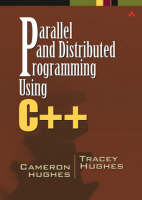
Parallel and Distributed Programming Using C++ (paperback)
Addison-Wesley Educational Publishers Inc (Verlag)
978-0-321-54467-4 (ISBN)
- Titel ist leider vergriffen;
keine Neuauflage - Artikel merken
CAMERON HUGHES is a senior software engineer for CTEST Laboratories and a staff programmer/analyst at Youngstown State University. He has been involved in software development efforts of all sizes and is currently working in cluster programming of the Proteus V that involves NLP and knowledge representation modeling at CTEST and the Colony at Youngstown. TRACEY HUGHES is a software engineer at CTEST, where she does graphics programming and simulation in C++ and develops image processing class libraries and virtual worlds. Together they are the co-authors of numerous books including Linux Rapid Application Development and Object-Oriented Multithreading Using C++.
Preface.
1. The Joys of Concurrent Programming.
What is Concurrency? The Benefits of Parallel Programming. The Benefits of Distributed Programming. The Minimal Effort Required. The Basic Layers of Software Concurrency. No Keyword Support for Parallelism in C++. Programming Environments for Parallel and Distributed Programming. Summary–Toward Concurrency.
2. The Challenges of Parallel and Distributed Programming.
The Big Paradigm Shift. Coordination Challenges. Sometimes Hardware Fails and Software Quits. Too Much Parallelization or Distribution Can Have Negative Consequences. Selecting a Good Architecture Requires Research. Different Techniques for Testing and Debugging are Required. The Parallel or Distributed Design Must Be Communicated. Summary.
3. Dividing C++ Programs into Multiple Tasks.
Process: A Definition. Anatomy of a Process. Process States. Process Scheduling. Context Switching. Creating a Process. Terminating a Process. Process Resources. What are Asynchronous and Synchronous Processes? Dividing the Program into Tasks. Summary.
4. Dividing C++ Programs into Multiple Threads.
Threads: A Definition. The Anatomy of a Thread. Thread Scheduling. Thread Resources. Thread Models. Introduction to the Pthread Library. The Anatomy of a Simple Threaded Program. Creating Threads. Managing Threads. Thread Safety and Libraries. Dividing Your Program into Multiple Threads. Summary.
5. Synchronizing Concurrency between Tasks.
Coordinating Order of Execution. Synchronizing Access to Data. What are Semaphores? Synchronization: An Object-Oriented Approach. Summary.
6. Adding Parallel Programming Capabilities to C++ through the PVM.
The Classic Parallelism Models Supported by PVM. The PVM Library for C++. The Basic Mechanics of the PVM. Accessing Standard Input (stdin) and Standard Output (stdout) within PVM Tasks. Summary.
7. Error Handling, Exceptions, and Software Reliability.
What is Software Reliability? Failures in Software Layers and Hardware Components. Definitions of Defects Depend on Software Specifications. Recognizing Where to Handle Defects versus Where to Handle Exceptions. Software Reliability: A Simple Plan. Using Map Objects in Error Handling. Exception Handling Mechanisms in C++. Event Diagrams, Logic Expressions, and Logic Diagrams. Summary.
8. Distributed Object-Oriented Programming in C++.
Decomposition and Encapsulation of the Work. Accessing Objects in Other Address Spaces. The Anatomy of a Basic CORBA Consumer. The Anatomy of a CORBA Producer. The Basic Blueprint of a CORBA Application. The Naming Service. A Closer Look at Object Adapters. Implementation and Interface Repositories. Simple Distributed Web Services Using CORBA. The Trading Service. The Client/Server Paradigm. Summary.
9. SPMD and MPMD Using Templates and the MPI.
Work Breakdown Structure for the MPI. Using Template Functions to Represent MPI Tasks. Simplifying MPI Communications. Summary.
10. Visualizing Concurrent and Distributed System Design.
Visualizing Structures. Visualizing Concurrent Behavior. Visualizing the Whole System. Summary.
11. Designing Components That Support Concurrency.
Taking Advantage of Interface Classes. A Closer Look at Object-Oriented Mutual Exclusion and Interface Classes. Maintaining the Stream Metaphor. User-Defined Classes Designed to Work with PVM Streams. Object-Oriented Pipes and fifos as Low-Level Building Blocks. Framework Classes Components for Concurrency. Summary.
12. Implementing Agent-Oriented Architectures.
What are Agents? What is Agent-Oriented Programming? Basic Agent Components. Implementing Agents in C++. Multiagent Systems. Summary.
13. Blackboard Architectures Using PVM, Threads, And C++ Components.
The Blackboard Model. Approaches to Structuring the Blackboard. The Anatomy of a Knowledge Source. The Control Strategies for Blackboards. Implementing the Blackboard Using CORBA Objects. Implementing the Blackboard Using Global Objects. Activating Knowledge Sources Using Pthreads. Summary.
Appendix A.
Class and Object Diagrams. Interaction Diagrams. State Diagrams. Package Diagrams.
Appendix B.
Bibliography.
Index.
| Erscheint lt. Verlag | 1.2.2008 |
|---|---|
| Verlagsort | New Jersey |
| Sprache | englisch |
| Maße | 100 x 100 mm |
| Gewicht | 100 g |
| Themenwelt | Informatik ► Software Entwicklung ► Objektorientierung |
| ISBN-10 | 0-321-54467-6 / 0321544676 |
| ISBN-13 | 978-0-321-54467-4 / 9780321544674 |
| Zustand | Neuware |
| Haben Sie eine Frage zum Produkt? |
aus dem Bereich


